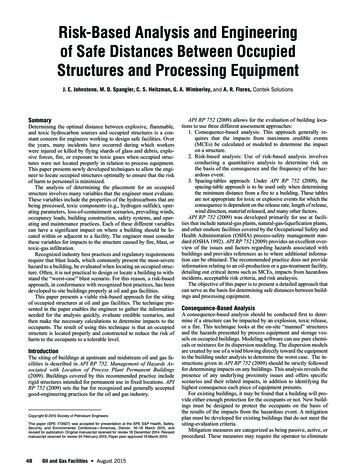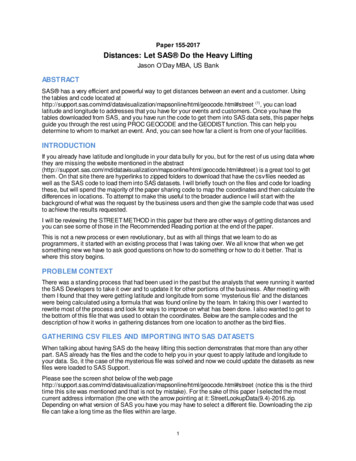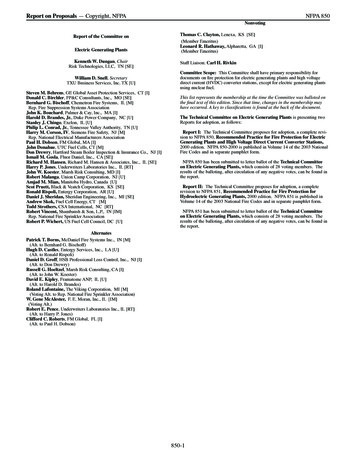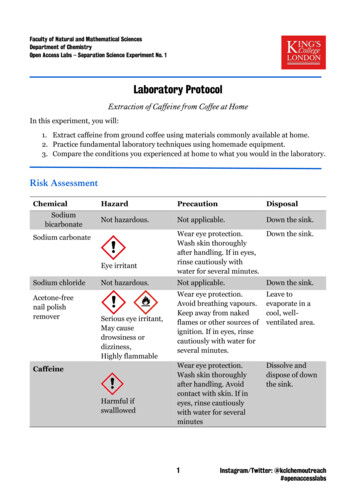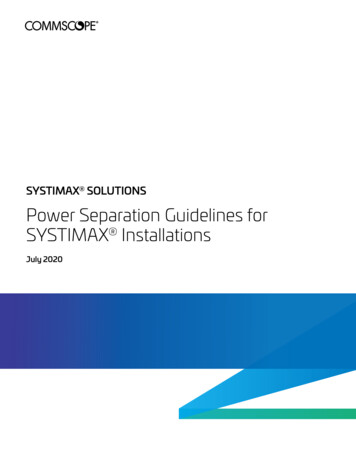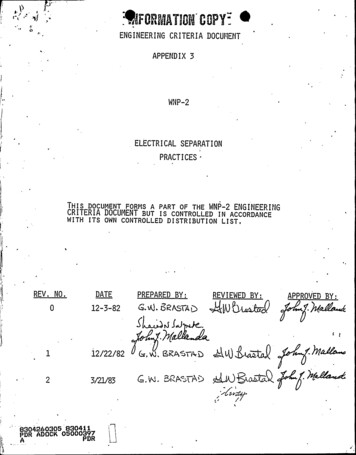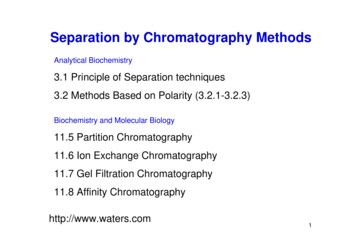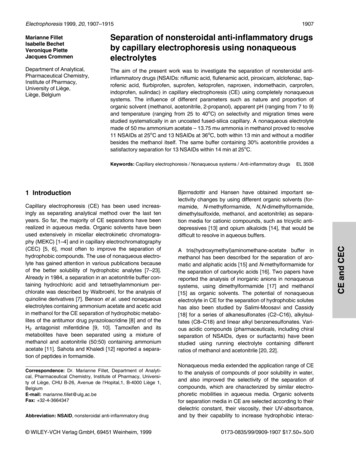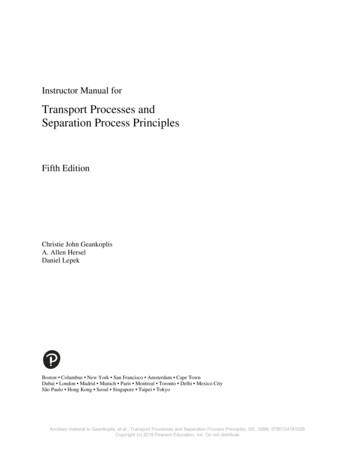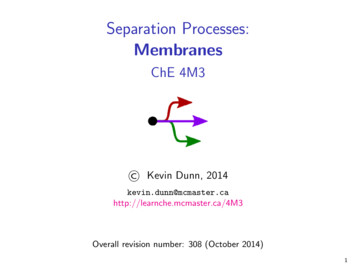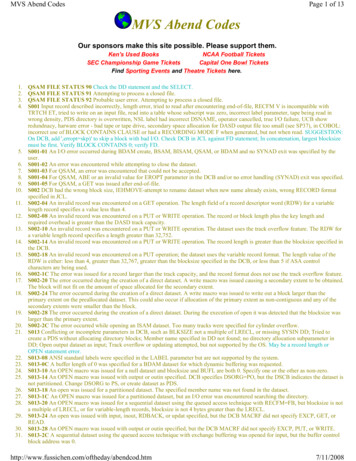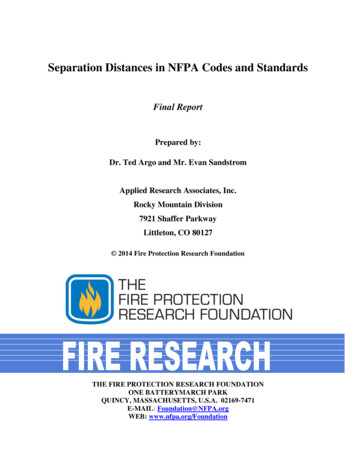
Transcription
Separation Distances in NFPA Codes and StandardsFinal ReportPrepared by:Dr. Ted Argo and Mr. Evan SandstromApplied Research Associates, Inc.Rocky Mountain Division7921 Shaffer ParkwayLittleton, CO 80127 2014 Fire Protection Research FoundationTHE FIRE PROTECTION RESEARCH FOUNDATIONONE BATTERYMARCH PARKQUINCY, MASSACHUSETTS, U.S.A. 02169-7471E-MAIL: Foundation@NFPA.orgWEB: www.nfpa.org/Foundation
—— Page c ——
—— Page ii ——
FOREWORDMany NFPA codes and standards, in particular NFPA 400, Hazardous Materials Code, specifyseparation/clearance distances for hazardous chemical storage and processes from other equipmentand occupied buildings. Many of these requirements have historical undocumented origins.Guidance, which may inform a sound technical basis for adjusting these distances, has beenrequested by NFPA Technical Committees. There are a number of methodologies in the literature,both risk and hazard based, which are used in the chemical safety process safety field that may berelevant to the calculation of these distances.The purpose of this project is to provide guidance to NFPA technical committees on methodologiesto develop technically based separation/clearance distances for hazardous chemicalstorage/processes and their application to the chemical storage and processes. The specific focusof the project is those hazards within the scope of NFPA 400.The Research Foundation expresses gratitude to the report author Dr. Ted Argo and Mr. EvanSandstrom, who is with Applied Research Associates, Inc located in Littleton, CO. The ResearchFoundation appreciates the guidance provided by the Project Technical Panelists and all othersthat contributed to this research effort. Thanks are also expressed to the National Fire ProtectionAssociation (NFPA) for providing the project funding through the NFPA Annual Code Fund.The content, opinions and conclusions contained in this report are solely those of the authors.About the Fire Protection Research FoundationThe Fire Protection Research Foundation plans, manages, and communicates research on a broadrange of fire safety issues in collaboration with scientists and laboratories around the world. TheFoundation is an affiliate of NFPA.About the National Fire Protection Association (NFPA)NFPA is a worldwide leader in fire, electrical, building, and life safety. The mission of theinternational nonprofit organization founded in 1896 is to reduce the worldwide burden of fire andother hazards on the quality of life by providing and advocating consensus codes and standards,research, training, and education. NFPA develops more than 300 codes and standards to minimizethe possibility and effects of fire and other hazards. All NFPA codes and standards can be viewedat no cost at www.nfpa.org/freeaccess.Keywords: high hazard industrial occupancy, passive fire protection, separation distances,NFPA 400—— Page iii ——
—— Page iv ——
PROJECT TECHNICAL PANELBen FergusonBob Zalosh, FirexploGuy Colonna, NFPADon HolmstromElizabeth Buc, FMRLJames Munger, James G. Munger & Associates, Inc.Jim Lathrop, Koffel Associates, Inc.Mark Dossett, San Diego Fire Rescue DepartmentMarty Gresho, FP2 Fire, Inc.Peter Howell, Mark V, Inc.Rich Craig, Compressed Gas AssociationStephen Haines, Haines Fire & Risk Consulting Corp.PROJECT SPONSORSNational Fire Protection Association—— Page v ——
—— Page vi ——
Final Report:Separation Distances in NFPA Codes and StandardsDecember 15, 2014Prepared for:The Fire Protection Research FoundationPrepared by:Applied Research Associates, Inc.Rocky Mountain Division7921 Shaffer ParkwayLittleton, CO 80127Principal Authors:Dr. Ted ArgoMr. Evan SandstromProgram Manager:Dr. Ted Argo
Separation Distances in NFPA Codes and StandardsTable of ContentsTable of Contents1. Introduction . 11.1. Project Description . 11.2. Program Organization . 22. Task 1: Literature Review . 32.1. Approach to the Literature Review. 32.2. Review of Specific Documents . 32.2.1. Methods for Vapor Cloud Explosion Blast Modelling . 32.2.2. Guidelines for Evaluating Process Plant Buildings for External Explosions,Fires, and Toxic Releases, Second Edition . 42.2.3. Effects of Blast Pressure on Structures and the Human Body. 52.2.4. Working Toward Exposure Thresholds for Blast Induced Traumatic BrainInjury: Thoracic and Acceleration Mechanisms . 72.2.5. Explosive Regulations of the Colorado State Division of Oil and PublicSafety . 82.2.6. Sympathetic Detonation of Ammonium Nitrate and Ammonium NitrateFuel Oil . 92.2.7. Department of Defense Contractor’s Safety Manual for Ammunition andExplosives . 102.2.8. New Developments in Explosion Protection Technology . 112.3. Summary of Review Findings . 113. Task 2: Test Report for Separation Distances for Ammonium Nitrate Solids . 133.1. Introduction and Purpose of This Case Study. 133.2. Description of Test Equipment . 133.2.1. Test Materials . 133.2.2. Test Instrumentation . 163.3. Test Setup . 183.3.1. AN Storage . 203.3.2. Wall Construction . 213.4. Test Method . 223.4.1. Test Setup . 223.4.2. Test Execution . 243.5. Results . 243.5.1. Qualitative Results of AN Behavior . 243.5.2. Qualitative Results of the Witness Plate . 283.5.3. Pressure Gauge Data. 28i
Separation Distances in NFPA Codes and StandardsTable of Contents3.6. Conclusions . 344. Task 3: Validation and Discussion of Separation Distance Development . 354.1. Comments on Separation Distances in NFPA 400 . 354.2. Methods for Developing Technically Based Separation Distances. 354.2.1. Risk-Based Approach . 364.2.2. Consequence-Based Approach . 374.3. Recommendations for Further Development . 375. Conclusions . 396. Investigator Biographies . 407. Works Cited . 418. Additional References . 43Appendix A. Technical Information on Test Materials . 45A.1Ammonium Nitrate – Fuel Oil . 45A.2Ammonium Nitrate . 49A.3Trojan Spartan Cast Booster . 53A.4Nonel Detonation Cord . 55A.5Nonel Lead Line. 57Appendix B. Kazarians and Associates Literature Review . 59List of FiguresFigure 1: The ANFO donor charge enclosed in a steel culvert. . 14Figure 2: The Industrial grade AN acceptor charges stored in super sacks. . 15Figure 3: The corrugated steel wall construction used for the process-to-personnelseparation evaluation. Left – Side facing toward the source. Right – Rear of thewall with blue foam witness plate. . 16Figure 4: A MeDAQ data acquisition system including computer interface is shownsituated in a fragment-resistant box. . 17Figure 5: Cameras deployed for the case study. Left – Model 5162 Phantom Camera.Right – GoPro Hero 3 Camera. . 17Figure 6: Foam witness plate used to detect any potentially hazardous fragments insimulated personnel-occupied areas. 18Figure 7: Location and satellite view of ARA’s PRTC facility. . 19ii
Separation Distances in NFPA Codes and StandardsTable of ContentsFigure 8: A schematic of the test setup. 19Figure 9: A satellite view of the explosives testing pad at ARA’s PRTC facility used forthis case study. The position of the pressure sensors, donor (ANFO), andacceptors (AN) are shown. 20Figure 10: Ground-level view of the AN acceptors in relation to the ANFO donor. . 21Figure 11: A satellite view of the explosives testing pads at ARA’s PRTC facility. Theposition of the wall is noted in relation to the donor (ANFO) and controlbunker. . 21Figure 12: A ground-level view of the wall construction used in this case studyincluding the location of the pressure sensors. . 22Figure 13: A typical pipe gauge stand for mounting pressure sensors shown with thesplitter plate and wiring. . 23Figure 14: Qualitative results for the AN storage containers. Clockwise: Before the test,all AN Acceptor; After the test, AN Acceptor 1 (42’); After the test, AN Acceptor2 (54’); After the test, AN Acceptor 3 (66’). . 25Figure 15: A frame from the Phantom camera video showing the fireball approachingAcceptor 2. . 26Figure 16: A frame from the Phantom camera video showing debris striking Acceptor2. . 26Figure 17: A frame from the Phantom camera video showing a secondary fireballbeginning to expand upward from the surface of Acceptor 2, normal to thedirection of propagation of the donor blast wave. . 27Figure 18: Front and back of the wall used to determine potential injury to personnelin this hazard scenario. . 27Figure 19: A frame taken from the GoPro camera showing the position of the wall andsensors. 28Figure 20: Time-pressure histories for the three nearfield pressure sensors.
15.12.2014 · Many NFPA codes and standards, in particular NFPA 400, Hazardous Materials Code, specify separation/clearance distances for hazardous chemical storage and processes from other equipment and occupied buildings. Many of these requirements have historical undocumented origins. Guidance, which may inform a sound technical basis for adjusting these distances, has been
